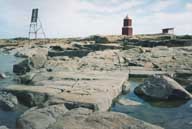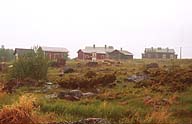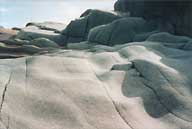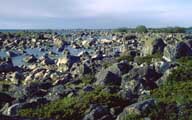Rönnskär
Visitors who come to the Rönnskär archipelago
by boat encounter outer skerries with many scattered islands and
islets where only the larger islands are forested. The area is
in the birch zone; only small stands of spruce are found. Heath
vegetation dominates the on the smaller islets. The beaches are
rocky and boulder-strewn, with the occasional cliff. Some of the
islands are relatively high and the wider channels are navigable
even for bigger boats.
Storskäret is the biggest of Rönnskär's
islands. On the west beach of the island is a legendary medieval
grave and a maze. On the east side of Storskär are several
fishing cottages, mainly used for recreational purposes. Storskär
has rich, lush vegetation with several interesting species such
as figwort (Scrophularia nodosa), wild
pansy (Viola tricolor), downy alpine
oatgrass (Avenula pubescens), male fern
(Dryopteris filix-mas) and marsh woundwort
(Stachys palustris). This wealth of plants is attributed to the
fact that Storskär is in an area with diabase, which is for
many plants a more favourable type of rock than granite and gneiss.
Two newcomers to the area's plants are gilmour (Centaurium
littorale), which is found on Bergö Gaddarna, and
Scottish lovage (Ligusticum scoticum),
which grows in a few places on Rönnskär. Around Bergö
Gaddarna south of Rönnskär the water is extremely rocky
and difficult to navigate, but the area is home to a variety of
birdlife. For example, a substantial portion of Finland's greater
scaups (Aythya marila) breed here.
If you visit the Rönnskär archipelago you will
probably go ashore on Fäliskäret. Fäliskäret
is the "centre" of Rönnskär with its wooden
beacon and former pilot station. The red wooden beacon was built
in 1784, and is Finland's oldest wooden beacon. Many buildings
have been built and some have also been torn down since then,
including pilot cottages, houses, bakeries, sheds, warehouses,
a windmill, a smithy and several barns.
The new pilot station was completed in 1966. When pilot
activities ended in 1983 the coast guard took over the buildings.
In 1997 the entire island with its buildings was transferred to
the ownership of Metsähallitus. Today the old residential
buildings are leased to organisations such as a yacht club and
diving society. The pilot station was renovated and converted
into a nature station with
accommodation for about 10 people. The previously white building
now has red siding to better fit in with the local setting. The
shipyard by the beach has also been renovated and now contains
bunks for 8 people, a beach sauna and exhibition facilities. The
facilities can be reserved directly through Metsähallitus
for various types of guided activities (contact information below).
Fäliskär is open with only a narrow line of
trees along the east beach. The northern part of the island is
rather high and rocky and there are lovely cliffs along the western
shore. The island narrows to the south where it is covered by
rocky heath. Visitors to the island in summer should stay close
to the houses and the cliffs on the north side of the island.
Many birds breed on the southern end of the island and they need
to be left in peace during summer.
|







